小学英语阅读教学教学模版设计
小学英语阅读教学作业设计模板

小学英语阅读教学作业设计模板一、教学目标通过本次阅读教学活动,学生能够:1. 掌握一定数量的核心词汇和短语;2. 熟悉并理解阅读材料中的基本句型结构;3. 提高阅读速度和理解能力;4. 培养学生对英语阅读的兴趣和自信心。
二、教学材料阅读材料应选择与学生年龄段和英语水平相适应的故事、文章或图片。
三、教学步骤1. 导入(5分钟)通过展示与阅读主题相关的图片、课堂谈话等方式引发学生的阅读兴趣。
2. 预习(10分钟)教师通过图片或简短的对话引导学生预测即将阅读的内容。
3. 阅读任务(20分钟)学生根据自己的阅读能力和年级特点进行阅读任务。
教师可以提供适量的帮助和指导,并鼓励学生用自己的语言进行表达。
4. 理解与巩固(15分钟)教师提问学生关于阅读材料的问题,并向学生提供相关的解释和补充材料来帮助他们更好地理解。
5. 阅读反思(10分钟)学生互相交流他们的阅读心得和体会,教师进行总结和点评。
6. 作业布置(5分钟)教师布置与阅读材料相关的作业,例如完成问题、写读后感等。
四、评价标准根据学生的阅读效果和参与度进行评价,包括阅读速度、理解能力和口语表达能力等方面的考量。
五、拓展活动为了进一步培养学生的阅读兴趣和能力,教师可以组织一些拓展活动,如阅读小组讨论、阅读比赛、阅读角色扮演等,以激发学生的学习热情。
六、教学反思教师应及时记录学生的表现和反馈,在教学过程中发现问题及时进行调整,以提高教学效果。
以上是小学英语阅读教学作业设计模板,根据实际情况,可以根据具体教学内容和学生特点进行适当的调整和修改。
希望通过这个模板可以帮助您设计出高效、有效的英语阅读教学作业。
小学英语阅读课教案模板全英文
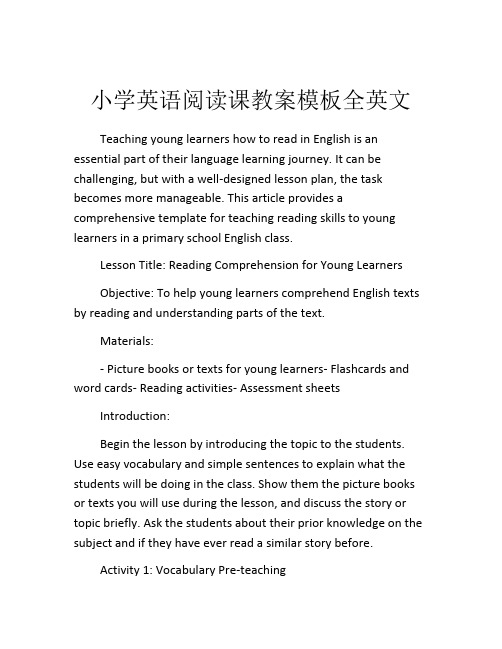
小学英语阅读课教案模板全英文Teaching young learners how to read in English is an essential part of their language learning journey. It can be challenging, but with a well-designed lesson plan, the task becomes more manageable. This article provides a comprehensive template for teaching reading skills to young learners in a primary school English class.Lesson Title: Reading Comprehension for Young LearnersObjective: To help young learners comprehend English texts by reading and understanding parts of the text.Materials:- Picture books or texts for young learners- Flashcards and word cards- Reading activities- Assessment sheetsIntroduction:Begin the lesson by introducing the topic to the students. Use easy vocabulary and simple sentences to explain what the students will be doing in the class. Show them the picture books or texts you will use during the lesson, and discuss the story or topic briefly. Ask the students about their prior knowledge on the subject and if they have ever read a similar story before.Activity 1: Vocabulary Pre-teachingIntroduce the students to new vocabulary words found in the text they will be reading. Use flashcards or word cards to facilitate this activity. Pronounce each word and ask the students to repeat it after you. Then, explain the meaning of each word and provide examples of how they are used. Drill the vocabulary words with the students till they are familiar with them.Activity 2: Reading AloudAsk the students to read the text aloud with you. Demonstrate how to pronounce each word correctly and encourage the students to follow your intonation. You can read some parts of the text first, then, ask the students to read alone, or in pairs. Ensure that everyone participates in reading the text.Activity 3: Comprehension QuestionsAsk the students comprehension questions based on the text. These questions should test their understanding of the story, what they have read and make sure to use vocabulary words that they learned earlier. For example;- What is the story about?- What happened in the story?- Who are the characters in the story? - Where did the story happen?- What did the characters do in the story?- What happened at the end of the story?Activity 4: Independent ReadingAllow students to read the text again on their own, either silently or out loud. Give the students a time frame for readingthe text. Circulate around the classroom and check their individual progress, addressing any queries or difficulties they have.Assessment:Assess each student's level of comprehension by having them complete an assessment sheet. The assessment sheet should be designed to test whether students have understood the story and its vocabulary words.Conclusion:Provide feedback to the students on their performance and encourage their progress. Play games or activities to reinforce their learning and make the class enjoyable and fun. End the class with a summary and reminder of the vocabulary words learned in the lesson.In summary, teaching young learners English reading comprehension involves ensuring that the students are engaged, taking steps to build their vocabulary and ensure they understand what they have read. Use specific teaching methods to activate their critical thinking, and create an environment that is interactive and fun. With this template lesson plan, you can strengthen the reading skills of young learners, prepare them for future learning, and set them on a path to mastering the English language.。
英语阅读教案三年级

三年级英语阅读教案一、教学目标:1.了解字母a,b,c的发音及写法;2.学习短语“Hello, my name is…”的表达以及用法;3.掌握指认简单的生活用品的词汇;4.阅读情境下的简单短文,了解短文的意思。
二、教学重点:1.学习短语“Hello, my name is…”的表达以及用法;2.掌握指认简单的生活用品的词汇。
三、教学难点:1.了解字母a,b,c的发音及写法;2.阅读情境下的简单短文,了解短文的意思。
四、教学方法:1.教师讲解与学生听讲相结合;2.师生情境模拟会话;3.听读相结合,分小组诵读短文。
五、教学过程:1.教学前:教师精心准备教具以及情境交际的背景。
2.教学中:步骤一:导入(1)教师和学生共同回顾上一节课所学内容,进行简单的巩固。
(2)教师通过拼写单词游戏,引导学生们逐渐熟悉字母a、b、c的发音及写法。
步骤二:学习新知(1)教师通过情境交际,向学生介绍一下自我介绍的表达方式:“Hello, my name is…”。
(2)教师带领学生认识一些生活用品的名字,如:book, pen, pencil, rubber, bag, ruler, pencil case等。
步骤三:练习和巩固(1)教师将生活用品放在课桌上,鼓励学生用英语将其指认并说出名字。
(2)老师和学生进行交流,模拟场景:“Hello, my name is…”,进行情境对话,即“这是什么?”和“这是一支笔”。
步骤四:输出知识(1)将生活用品按一定的规律摆放,库容易让学生记忆和理解,从而更好地掌握知识;(2)将学生分成小组,听读短文。
六、教学总结:通过本堂课,学生们掌握了字母a、b、c的发音及写法,学习了短语“Hello, my name is…”的表达以及用法,掌握了指认简单的生活用品的词汇。
同时,学生还通过情境交际进行模拟会话,从而提高了对英语的理解与应用能力。
希望学生们能够在的学习中不断掌握新的知识,更好地学习英语。
小学英语教资阅读教学设计
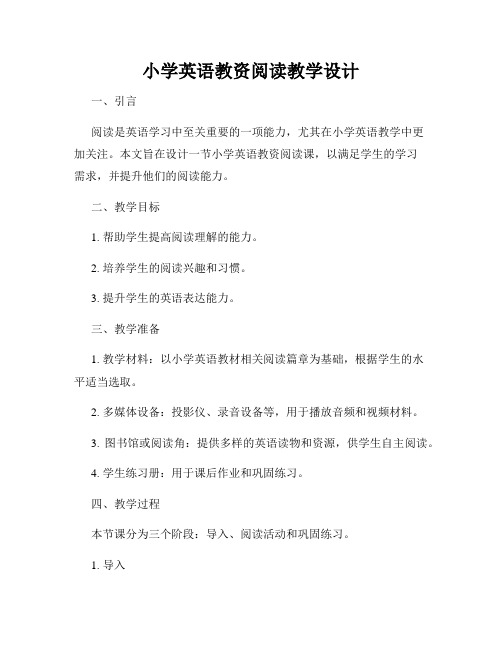
小学英语教资阅读教学设计一、引言阅读是英语学习中至关重要的一项能力,尤其在小学英语教学中更加关注。
本文旨在设计一节小学英语教资阅读课,以满足学生的学习需求,并提升他们的阅读能力。
二、教学目标1. 帮助学生提高阅读理解的能力。
2. 培养学生的阅读兴趣和习惯。
3. 提升学生的英语表达能力。
三、教学准备1. 教学材料:以小学英语教材相关阅读篇章为基础,根据学生的水平适当选取。
2. 多媒体设备:投影仪、录音设备等,用于播放音频和视频材料。
3. 图书馆或阅读角:提供多样的英语读物和资源,供学生自主阅读。
4. 学生练习册:用于课后作业和巩固练习。
四、教学过程本节课分为三个阶段:导入、阅读活动和巩固练习。
1. 导入教师可以通过播放一段与篇章主题相关的视频或音频来引起学生的兴趣。
同时,教师可以提问学生关于该主题的问题,激发他们的思考和讨论。
2. 阅读活动(1)前导活动教师可以通过展示一些与篇章内容相关的图片或单词,让学生预测文章的内容,并复习一些与主题相关的词汇。
(2)整体阅读教师同学生一起朗读篇章,逐句解读并讲解生词、短语或句子结构,帮助学生理解文章主旨和关键信息。
(3)细节理解教师可提出一些与篇章内容相关的问题,引导学生通过阅读找到答案。
可以进行小组合作或全班讨论,鼓励学生互相交流和分享自己的理解。
(4)阅读扩展教师鼓励学生通过阅读相关的资料或故事书籍,进一步拓展对主题的理解和知识。
3. 巩固练习教师可以设计一些与篇章内容相关的练习题,包括填空、选择、判断等形式,帮助学生巩固所学内容。
同时,可以要求学生以小组或个人形式撰写一篇短文,总结他们对篇章的理解和观点。
五、教学评估教师可以通过观察学生课堂表现、课后作业和个别交流等方式评估学生的阅读理解水平。
同时,教师也要注重对学生学习兴趣和参与度的评估,以便及时调整教学策略。
六、教学延伸教师鼓励学生积极参加校内外的英语阅读活动,如阅读比赛、阅读俱乐部等。
同时,可以推荐一些适合学生阅读的英语原版儿童读物,并组织讨论、分享和读书报告等活动,进一步培养学生的阅读兴趣和能力。
小学英文阅读指导教案模板

小学英文阅读指导教案模板一、教案基本信息- 学科:英语- 年级:小学 ___ 年级- 课时:___ 课时- 教材版本:人教版(或其他版本)- 教学目标:培养学生对英文阅读的兴趣,提高阅读理解能力。
二、教学内容- 主题:___ (例如:动物、自然、家庭等)- 文本:___ (例如:《The Cat in the Hat》、《Green Eggs and Ham》等)- 词汇:___ (列出本节课需要掌握的词汇)- 语法:___ (列出本节课需要掌握的语法点)三、教学目标1. 知识目标:- 学生能够理解文本的大意,掌握关键词汇和语法点。
- 学生能够运用所学知识进行简单的阅读和口语表达。
2. 能力目标:- 学生能够通过阅读提高英语思维能力和语言运用能力。
- 学生能够培养良好的阅读习惯和阅读兴趣。
3. 情感目标:- 学生能够喜欢英语阅读,感受阅读的乐趣。
- 学生能够培养合作精神,与他人分享阅读心得。
四、教学步骤1. 导入(5分钟):- 教师通过图片、歌曲、游戏等方式引导学生进入学习状态。
- 教师提出本节课的学习目标,激发学生的学习兴趣。
2. 文本阅读(15分钟):- 教师引导学生阅读文本,回答相关问题。
- 教师帮助学生理解文本大意,解释生词和语法点。
3. 活动一(10分钟):- 教师组织学生进行小组活动,讨论阅读心得。
- 学生通过角色扮演、绘制思维导图等形式巩固所学知识。
4. 活动二(10分钟):- 教师设计趣味性阅读任务,如阅读接力、阅读竞赛等。
- 学生通过完成任务,提高阅读速度和理解能力。
5. 总结与拓展(5分钟):- 教师对本节课所学内容进行总结,强调重点。
- 教师推荐相关阅读材料,激发学生的阅读兴趣。
五、作业布置- 学生完成课后阅读练习。
- 学生绘制文本故事情节图。
- 学生编写阅读心得体会。
六、教学反思教师在课后对教学效果进行反思,分析学生的学习情况,针对性地调整教学方法和策略。
{content}。
小学英语读写课说课稿模板

小学英语读写课说课稿模板尊敬的各位评委老师,大家好。
今天我要进行说课的课程是小学英语读写课,课程的主题是“我的家庭”。
本节课旨在通过阅读和写作活动,让学生能够描述家庭成员并表达对家人的情感。
课程目标:1. 知识与技能:学生能够理解并使用描述家庭成员的词汇和句型。
2. 过程与方法:通过小组合作和角色扮演等活动,提高学生的英语口语表达能力和写作技巧。
3. 情感态度与价值观:培养学生对家庭的热爱和对家人的感激之情。
教学重点:- 家庭成员的英文表达。
- 描述家庭成员外貌和性格特征的句型。
教学难点:- 学生能够灵活运用描述家庭成员的句型进行写作。
教学准备:- 家庭主题的图片和卡片。
- 相关的英语词汇表。
- 写作练习纸和笔。
教学过程:1. 导入(Lead-in):- 通过展示家庭主题的图片,激发学生的兴趣。
- 提问学生关于家庭成员的简单问题,如“Who is in yourfamily?”等。
2. 呈现(Presentation):- 教授描述家庭成员的词汇,如father, mother, brother, sister等。
- 通过图片和卡片,教授学生如何描述家庭成员的外貌和性格。
3. 练习(Practice):- 分组进行角色扮演,每个学生轮流描述自己的家庭成员。
- 教师提供句型模板,如“My father is tall and strong. He is very kind.”4. 应用(Application):- 引导学生进行写作练习,让他们写下关于自己家庭成员的短文。
- 教师巡回指导,帮助学生纠正语法和拼写错误。
5. 总结(Summary):- 邀请几位学生分享他们的写作作品。
- 教师总结本节课学到的词汇和句型。
6. 作业(Homework):- 要求学生回家继续练习写作,描述一个家庭成员,并在下节课上进行分享。
教学反思:本节课通过多种活动,让学生在轻松愉快的氛围中学习英语。
通过角色扮演和写作练习,学生能够更好地掌握描述家庭成员的英语表达。
英语三年级下册阅读教案

英语三年级下册阅读教案
一、教学目标
1. 帮助学生提高英语阅读理解能力。
2. 通过阅读,培养学生的表达和思维能力。
3. 培养学生良好的阅读惯和兴趣。
二、教学内容
1. 单词研究:教授新单词,并巩固已研究的单词。
2. 课文阅读:选择适合学生水平的课文进行阅读。
3. 阅读理解:通过问题和练,加深学生对课文的理解。
三、教学步骤
1. 导入:通过游戏或歌曲引起学生研究英语的兴趣。
2. 单词研究:通过图片和声音教授新单词,并进行读音练。
3. 课文阅读:教师读课文,学生跟读,并进行语音纠正。
4. 阅读理解:提问学生有关课文的问题,并帮助学生回答。
5. 拓展练:通过小组活动或课堂游戏练课文内容。
四、教学评估
1. 课堂表现:观察学生上课时的参与度、问题的回答等。
2. 作业情况:布置课后阅读练,检查学生的理解和答案。
3. 小测验:定期进行小测验,检验学生对阅读内容的掌握程度。
五、教学资源
1. 课本:使用学校规定的英语教材。
2. 多媒体设备:使用投影仪或电视播放课文和相关素材。
六、教学反思
本教案通过多种教学方法,如单词学习、课文阅读和阅读理解,促进学生英语阅读能力的提高。
同时,通过游戏和小组活动等形式,增加了学习的趣味性和参与度。
教师可以根据学生的实际情况进行
适当调整,以提高教学效果。
教资英语阅读教学设计模板
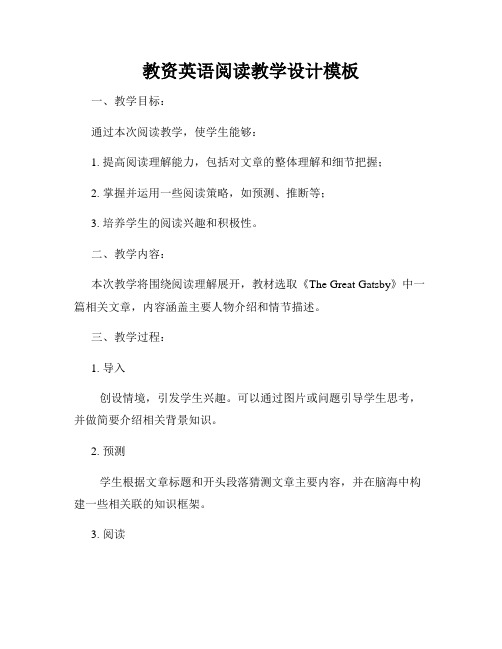
教资英语阅读教学设计模板一、教学目标:通过本次阅读教学,使学生能够:1. 提高阅读理解能力,包括对文章的整体理解和细节把握;2. 掌握并运用一些阅读策略,如预测、推断等;3. 培养学生的阅读兴趣和积极性。
二、教学内容:本次教学将围绕阅读理解展开,教材选取《The Great Gatsby》中一篇相关文章,内容涵盖主要人物介绍和情节描述。
三、教学过程:1. 导入创设情境,引发学生兴趣。
可以通过图片或问题引导学生思考,并做简要介绍相关背景知识。
2. 预测学生根据文章标题和开头段落猜测文章主要内容,并在脑海中构建一些相关联的知识框架。
3. 阅读学生开始读文章,可以分段或整篇阅读。
提醒学生注意细节,并标注或摘录关键信息。
4. 理解同学们用自己的话解释文章中的难点词汇或句子,并寻找文章中的主题句。
鼓励学生结合上下文进行推理与猜测。
5. 细节把握学生根据问题或要求,仔细寻找相关细节回答问题或完成任务。
可以编写问题集或任务卡,并进行小组或个人活动。
6. 操作应用学生根据文章内容,进行相关操作性活动,如填表、写作等。
7. 总结与拓展学生对文章内容、阅读过程中的问题和策略进行总结,可以进行小组或全班分享。
并提供额外的拓展阅读材料,以便学生进一步提高阅读能力。
四、教学资源:1. 选取的阅读材料《The Great Gatsby》相关文章;2. 学生阅读材料和活动相关问题集或任务卡;3. 阅读策略提示卡;4. 可选的拓展阅读材料。
五、教学评估:1. 平时表现观察,包括学生的参与度、语言运用、思考能力等;2. 阅读活动期间的听说读写能力表现;3. 针对性的小测或作业,检验学生对文章内容的理解程度和运用能力。
六、教学反思与改进:根据学生的实际表现和教学反馈,及时调整教学策略和活动形式,使教学更贴近学生需求和实际应用。
并结合教学反思,不断完善和改进教学设计模板。
以上是教资英语阅读教学设计模板,根据该模板进行教学设计可帮助教师在教学过程中有效指导学生进行阅读理解,提高他们的阅读能力和学习效果。
小学英语阅读教案万能模板

小学英语阅读教案万能模板小学英语阅读是英语教学中非常重要的一个环节,小学阶段是英语学习的关键期,培养小学生的阅读能力对于以后的英语学习具有非常积极的影响。
因此,小学英语阅读教学的重要性无可替代。
本文将提供一份小学英语阅读教案的万能模板,以帮助小学英语教师更好地指导学生进行英语阅读教学。
一、教学目标:掌握词汇、语法和句式,注重交际功能,让学生理解阅读材料的主旨,加深对英语文化的理解。
二、教学重点:发展学生的阅读技能和交际能力,帮助学生能够理解所读文章的主旨和细节,并从中获得知识和价值观。
三、教学难点:不同难度层次的阅读材料的选择以及如何引导学生思考、讨论和理解英语文化。
四、教学准备:教师需要准备一些适合不同学生水平的阅读材料,并准备一些教学辅助材料如单词卡片、CD播放器等。
五、教材分析:教师应该根据学生的年龄和英语水平,选择一些适合学生的阅读材料。
例如,学生可以阅读童话故事、简单的英语文章等,在这些材料中,学生可以学习基本的英语单词、语法和句型,同时培养学生的阅读能力和交际能力。
六、教学过程:1.导入:教师可以通过歌曲、卡通角色和图片等方式来引入今天的教学内容,并介绍本次英语阅读的主题。
例如,教师可以用某一个故事作为主题,让学生先说说自己听过这个故事吗?有哪些细节呢?2.阅读:教师可以先让学生自己大声朗读故事或文章,然后给他们时间阅读并理解文章的大意。
接着,教师可以用各种方式帮助学生理解文章的关键词汇和句子。
例如,教师可以请学生找出文章中的关键单词,并解释它们的含义,或是请学生回答一些与文章相关的问题。
3.交流:教师可以组织学生进行交流和讨论,让他们互相分享自己的理解和评论。
例如,教师可以让学生小组互动,讨论他们所读的故事的主题、情节和人物,并让他们自由表达自己的看法和想法。
4.全班总结:教师应该引导学生将所学的知识进行总结,掌握故事的主题和情节,并回答一些与故事相关的问题。
例如,教师可以让学生整理故事中的关键单词和短语,让他们回答一些问题,检查学生对故事的理解程度。
小学英文阅读指导教案模板
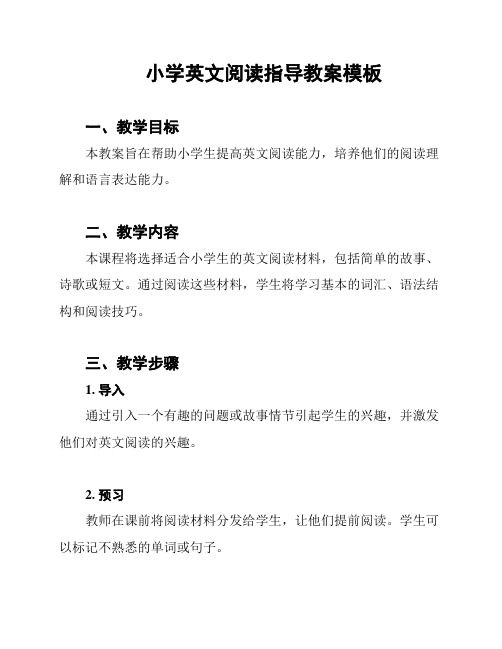
小学英文阅读指导教案模板一、教学目标本教案旨在帮助小学生提高英文阅读能力,培养他们的阅读理解和语言表达能力。
二、教学内容本课程将选择适合小学生的英文阅读材料,包括简单的故事、诗歌或短文。
通过阅读这些材料,学生将学习基本的词汇、语法结构和阅读技巧。
三、教学步骤1. 导入通过引入一个有趣的问题或故事情节引起学生的兴趣,并激发他们对英文阅读的兴趣。
2. 预习教师在课前将阅读材料分发给学生,让他们提前阅读。
学生可以标记不熟悉的单词或句子。
3. 阅读学生在课堂上朗读阅读材料,并尝试理解其中的内容。
教师可以提供适当的指导,帮助学生理解文章的主旨和细节。
4. 讨论教师与学生一起讨论阅读材料中的问题和观点。
学生可以分享自己的理解和观点,并与同学进行互动交流。
5. 语言拓展教师可以引导学生学习新的词汇和语法结构,以丰富他们的语言表达能力。
6. 写作练习学生可以根据阅读材料进行写作练习,包括写一篇文章、写一封信或进行简短的写作任务。
7. 总结教师与学生一起总结本节课的学习内容,并鼓励学生继续阅读和学习英文。
四、教学评估教师可以通过观察学生的阅读表现、听取学生的观点和评估学生的写作作品来评估他们的英文阅读能力。
五、教学资源教师准备合适的英文阅读材料、课堂讲义、词汇表等资源,以支持学生的学习。
六、教学延伸教师可以鼓励学生在课后继续阅读英文材料,并提供相关的阅读推荐和学习资源。
七、教学反思教师应及时反思教学过程,总结教学经验,并根据学生的实际情况进行相应的调整和改进。
以上为小学英文阅读指导教案模板,根据实际教学情况和学生的需求,可以适当调整和修改。
希望能对您的教学工作有所帮助!。
英语阅读课的教案范例
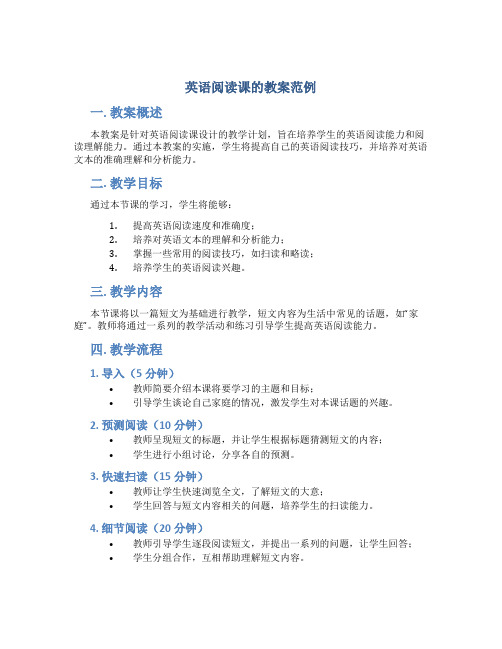
英语阅读课的教案范例一. 教案概述本教案是针对英语阅读课设计的教学计划,旨在培养学生的英语阅读能力和阅读理解能力。
通过本教案的实施,学生将提高自己的英语阅读技巧,并培养对英语文本的准确理解和分析能力。
二. 教学目标通过本节课的学习,学生将能够:1.提高英语阅读速度和准确度;2.培养对英语文本的理解和分析能力;3.掌握一些常用的阅读技巧,如扫读和略读;4.培养学生的英语阅读兴趣。
三. 教学内容本节课将以一篇短文为基础进行教学,短文内容为生活中常见的话题,如“家庭”。
教师将通过一系列的教学活动和练习引导学生提高英语阅读能力。
四. 教学流程1. 导入(5分钟)•教师简要介绍本课将要学习的主题和目标;•引导学生谈论自己家庭的情况,激发学生对本课话题的兴趣。
2. 预测阅读(10分钟)•教师呈现短文的标题,并让学生根据标题猜测短文的内容;•学生进行小组讨论,分享各自的预测。
3. 快速扫读(15分钟)•教师让学生快速浏览全文,了解短文的大意;•学生回答与短文内容相关的问题,培养学生的扫读能力。
4. 细节阅读(20分钟)•教师引导学生逐段阅读短文,并提出一系列的问题,让学生回答;•学生分组合作,互相帮助理解短文内容。
5. 理解与分析(15分钟)•教师引导学生对短文进行理解和分析,提出一些开放性问题供学生思考和讨论;•学生进行小组讨论,分享自己的观点和答案。
6. 小结与拓展(10分钟)•教师对课堂内容进行总结,强调学生在本节课中学到的重点知识和技巧;•教师布置相关阅读作业,加深学生对英语阅读的训练和应用。
五. 教学方法本节课采用多种教学方法,如导入讨论、小组合作、问题引导等方法,旨在激发学生的英语阅读兴趣,提高他们的阅读能力。
六. 教学评估本节课的教学评估主要通过以下几种方式进行:•学生在课堂上的积极参与程度;•学生在小组讨论和问题回答中的表现;•学生对文章内容的准确理解和分析能力。
七. 教学资源•短文《家庭》(准备足够的复印件供学生使用);•问题练习;•小组讨论指南。
小学英语阅读教案计划

小学英语阅读教案计划课时:1课时年级:小学四年级教学目标:1. 能正确朗读课文,理解课文大意。
2. 能运用所学词汇和句型进行简单的交流。
3. 培养学生的阅读兴趣,提高阅读能力。
4. 引导学生学会关爱动物,与动物和谐相处。
教学内容:1. 课文:《The Cat and the Mouse》2. 词汇:cat, mouse, run, chase, hole, hide等。
3. 句型:What's this? It's a/an... How old is it? It's... years old.教学过程:Step 1: Lead-in(5分钟)1. 教师展示一张猫和老鼠的图片,引导学生说出它们的英文名称。
2. 教师询问学生是否知道猫和老鼠的特点,引导学生用英语进行回答。
Step 2: Pre-reading(5分钟)1. 教师给出课文标题《The Cat and the Mouse》,引导学生猜测课文内容。
2. 教师快速浏览课文,引导学生关注关键词汇。
Step 3: While-reading(10分钟)1. 教师引导学生跟随课文朗读,注意语音语调。
2. 教师暂停课文,针对关键词汇进行讲解和练习。
3. 教师引导学生回答课文内容相关问题,检查学生对课文的理解。
Step 4: Post-reading(10分钟)1. 教师组织学生进行角色扮演,表演课文故事。
2. 教师引导学生运用所学词汇和句型进行小组交流,讨论自己喜欢的动物。
Step 5: Summary(5分钟)1. 教师引导学生总结本节课所学内容。
2. 教师强调关爱动物,与动物和谐相处的重要性。
Step 6: Homework(5分钟)1. 学生回家后,和家长一起寻找其他关于猫和老鼠的故事,分享给家长。
2. 学生和家长一起完成课后练习题。
教学评价:1. 课后收集学生的角色扮演视频,观察学生的口语表达和表演能力。
2. 检查课后练习题完成情况,了解学生的学习效果。
小学英语绘本讲读教案模板

教学对象:二年级学生教学目标:1. 培养学生对英语绘本的兴趣,提高阅读能力。
2. 通过绘本阅读,帮助学生掌握相关词汇和句型。
3. 培养学生的观察力、想象力和创造力。
教学内容:《Brown bear, brown bear, what do you see?》(棕熊,棕熊,你在看什么?)教学时间:40分钟教学准备:1. 英语绘本《Brown bear, brown bear, what do you see?》2. 彩色图片或实物,如熊、鸟、鱼等3. 多媒体课件4. 录音设备教学过程:一、导入(5分钟)1. 播放绘本中的音乐,让学生感受绘本的氛围。
2. 提问:同学们,你们喜欢听故事吗?今天我们要学习一本有趣的英语绘本。
二、绘本阅读(20分钟)1. 让学生自主阅读绘本,注意观察图片和文字。
2. 教师逐页讲解绘本内容,引导学生理解故事情节。
3. 教师引导学生找出绘本中的重点词汇和句型,如:brown bear, red bird, yellow duck等。
三、互动活动(15分钟)1. 游戏环节:教师出示彩色图片或实物,让学生用英语描述,如:“What do yo u see? I see a red bird.”2. 创意环节:让学生发挥想象力,用自己的语言续写故事,如:“What do you think the brown bear will do next?”四、总结与作业(10分钟)1. 教师总结绘本内容,强调重点词汇和句型。
2. 布置作业:让学生用英语复述故事,或画出自己最喜欢的角色。
教学反思:1. 本节课通过绘本阅读,激发了学生对英语学习的兴趣,提高了他们的阅读能力。
2. 在互动活动中,学生的参与度较高,充分发挥了他们的想象力和创造力。
3. 教师应注重培养学生的语言表达能力和思维能力,提高他们的英语综合运用能力。
教学评价:1. 学生对绘本的兴趣和阅读能力是否有所提高。
2. 学生在互动活动中的表现,如词汇运用、故事复述等。
人教版小学五年级英语阅读课教案范文模板5篇
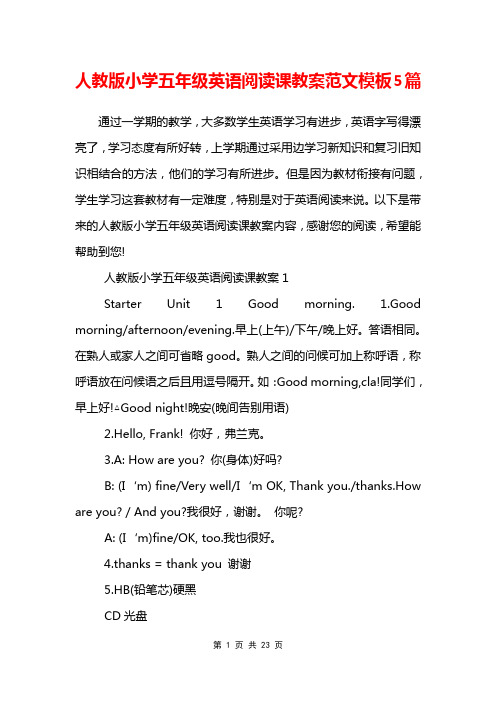
人教版小学五年级英语阅读课教案范文模板5篇通过一学期的教学,大多数学生英语学习有进步,英语字写得漂亮了,学习态度有所好转,上学期通过采用边学习新知识和复习旧知识相结合的方法,他们的学习有所进步。
但是因为教材衔接有问题,学生学习这套教材有一定难度,特别是对于英语阅读来说。
以下是带来的人教版小学五年级英语阅读课教案内容,感谢您的阅读,希望能帮助到您!人教版小学五年级英语阅读课教案1Starter Unit 1 Good morning. 1.Good morning/afternoon/evening.早上(上午)/下午/晚上好。
答语相同。
在熟人或家人之间可省略good。
熟人之间的问候可加上称呼语,称呼语放在问候语之后且用逗号隔开。
如:Good morning,cla!同学们,早上好!△Good night!晚安(晚间告别用语)2.Hello, Frank! 你好,弗兰克。
3.A: How are you? 你(身体)好吗?B: (I‘m) fine/Very well/I‘m OK, Thank you./thanks.How are you? / And you?我很好,谢谢。
你呢?A: (I‘m)fine/OK, too.我也很好。
4.thanks = thank you 谢谢5.HB(铅笔芯)硬黑CD光盘BBC英国广播公司Starter Unit 2 What‘s this in English? 1.What‘s this/that? 这/那是什么?It’s a/an + 单数物品(△不说This/That is)1) What‘s this/that? 这/那是什么? 2) What‘s this/that? 这/那是什么?It’s a ruler.(这/那是)直尺。
It’s an apple.(这/那是)苹果。
2.What‘s this/that in English? 这/那用英语怎么说?It’s a/an + 单数物品(△不说This/That is)What‘s this in English? 这用英语怎么说? It’s a jacket.夹克衫What‘s that in English? 那用英语怎么说?It’s an orange.橘子。
小学英语阅读课教学设计模板范文
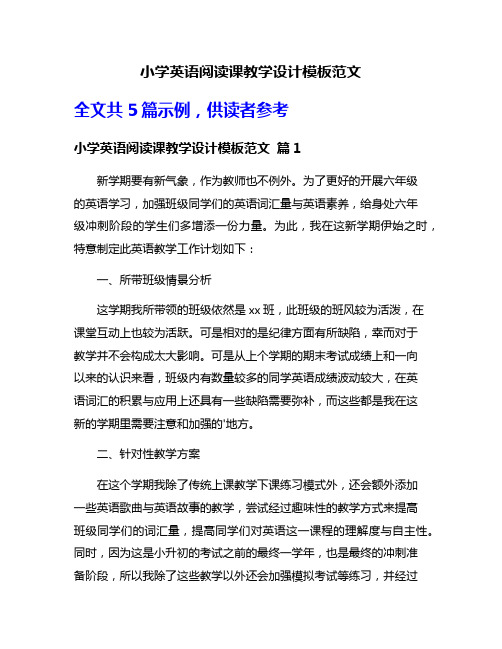
小学英语阅读课教学设计模板范文全文共5篇示例,供读者参考小学英语阅读课教学设计模板范文篇1新学期要有新气象,作为教师也不例外。
为了更好的开展六年级的英语学习,加强班级同学们的英语词汇量与英语素养,给身处六年级冲刺阶段的学生们多增添一份力量。
为此,我在这新学期伊始之时,特意制定此英语教学工作计划如下:一、所带班级情景分析这学期我所带领的班级依然是xx班,此班级的班风较为活泼,在课堂互动上也较为活跃。
可是相对的是纪律方面有所缺陷,幸而对于教学并不会构成太大影响。
可是从上个学期的期末考试成绩上和一向以来的认识来看,班级内有数量较多的同学英语成绩波动较大,在英语词汇的积累与应用上还具有一些缺陷需要弥补,而这些都是我在这新的学期里需要注意和加强的'地方。
二、针对性教学方案在这个学期我除了传统上课教学下课练习模式外,还会额外添加一些英语歌曲与英语故事的教学,尝试经过趣味性的教学方式来提高班级同学们的词汇量,提高同学们对英语这一课程的理解度与自主性。
同时,因为这是小升初的考试之前的最终一学年,也是最终的冲刺准备阶段,所以我除了这些教学以外还会加强模拟考试等练习,并经过研究历年考试真题来进行有针对性的考前培训,提高学生的答题技巧以及知识运用本事。
三、个人教学工作准备1、加强自身学习研究,经过历年的考试真题来对考试可能会出现的题型题目进行一些预测,并针对预测结果来进行教学准备,以提高学生的考试本事。
2、加强与孩子们的沟通交流,明白他们学习的难点在哪里,了解自我在教学中的不足并加以改正,力求经过这种方式来让我于班级同学融为一体,共同加强学习,共同为了提高而努力奋斗。
3、一个班级中总是有成绩的高低,所以我要发挥出教师的耐心与本事来悉心教导,不抛弃任何一个学生,督促先进生,鼓励后进生,引导整个班级学习风气的前进。
在新学期里,仅靠着我一人的努力是肯定不足的,我需要设法培养起学生们的学习热情,带动起全班同学们一齐努力,自发的向上才能够在激励的竞争中考取更好的学校,理解更好的教育,在以后成为一个对祖国、对人民有贡献的栋梁之才。
小学英语阅读课教案模板一等奖
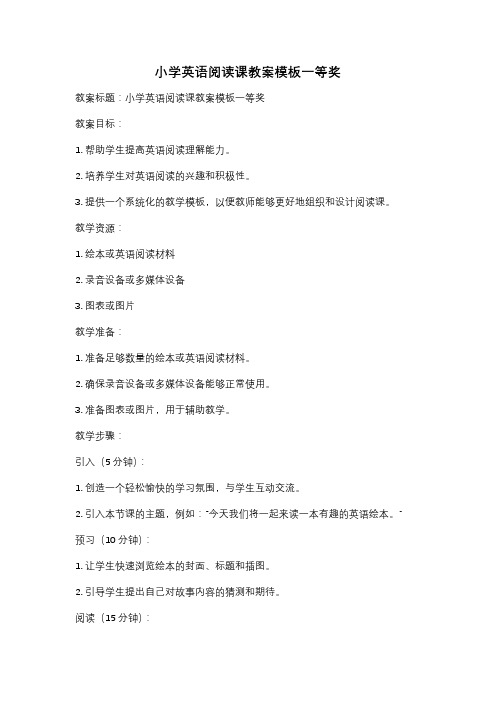
小学英语阅读课教案模板一等奖教案标题:小学英语阅读课教案模板一等奖教案目标:1. 帮助学生提高英语阅读理解能力。
2. 培养学生对英语阅读的兴趣和积极性。
3. 提供一个系统化的教学模板,以便教师能够更好地组织和设计阅读课。
教学资源:1. 绘本或英语阅读材料2. 录音设备或多媒体设备3. 图表或图片教学准备:1. 准备足够数量的绘本或英语阅读材料。
2. 确保录音设备或多媒体设备能够正常使用。
3. 准备图表或图片,用于辅助教学。
教学步骤:引入(5分钟):1. 创造一个轻松愉快的学习氛围,与学生互动交流。
2. 引入本节课的主题,例如:“今天我们将一起来读一本有趣的英语绘本。
”预习(10分钟):1. 让学生快速浏览绘本的封面、标题和插图。
2. 引导学生提出自己对故事内容的猜测和期待。
阅读(15分钟):1. 逐页阅读绘本,或播放录音材料,让学生跟读或聆听。
2. 引导学生理解故事情节、人物和关键词。
3. 提问学生关于故事的问题,鼓励他们回答并表达自己的观点。
理解(15分钟):1. 给学生分发或展示相关的图表或图片,帮助他们更好地理解故事。
2. 引导学生回答与故事相关的问题,帮助他们深入理解故事的细节和主题。
3. 鼓励学生用自己的话复述故事的主要内容。
拓展(10分钟):1. 引导学生进行角色扮演或小组讨论,让他们运用故事中的语言和情境。
2. 提供额外的阅读材料,让学生继续阅读和探索英语阅读的乐趣。
3. 鼓励学生分享自己的阅读经验和喜爱的英语绘本。
总结(5分钟):1. 总结本节课的重点和要点。
2. 鼓励学生提出问题和反馈意见。
3. 激发学生对下一节课的期待和兴趣。
教学延伸:1. 鼓励学生积极参与课堂活动,提高英语口语表达能力。
2. 提供更多的英语阅读资源,让学生继续锻炼和提高阅读能力。
3. 定期评估学生的阅读理解水平,及时调整教学内容和方法。
教学评估:1. 观察学生在课堂上的参与程度和表现。
2. 检查学生在课后完成的阅读任务或练习。
小学英语阅读课教学设计模板范文
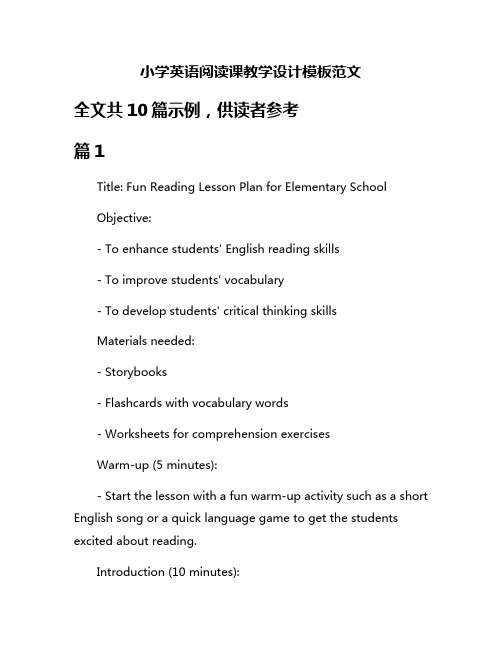
小学英语阅读课教学设计模板范文全文共10篇示例,供读者参考篇1Title: Fun Reading Lesson Plan for Elementary SchoolObjective:- To enhance students' English reading skills- To improve students' vocabulary- To develop students' critical thinking skillsMaterials needed:- Storybooks- Flashcards with vocabulary words- Worksheets for comprehension exercisesWarm-up (5 minutes):- Start the lesson with a fun warm-up activity such as a short English song or a quick language game to get the students excited about reading.Introduction (10 minutes):- Introduce the storybook to the students and talk about its title, author, and the main characters. Encourage students to make predictions about what the story might be about.Reading (15 minutes):- Read the story aloud to the students, pausing to explain any difficult words or concepts. Encourage students to follow along in their own copies of the storybook.Vocabulary (10 minutes):- Use flashcards to introduce and review key vocabulary words from the story. Have students practice saying the words aloud and use them in sentences.Comprehension exercises (15 minutes):- Distribute worksheets with comprehension questions related to the story. Have students work individually or in pairs to answer the questions and discuss their answers.Discussion (10 minutes):- Lead a class discussion about the story, asking students to share their thoughts on the plot, characters, and themes. Encourage students to ask questions and express their opinions.Wrap-up (5 minutes):- Review the main points of the lesson and remind students of the importance of reading in English. Assign homework such as reading another storybook or writing a short summary of the lesson.Conclusion:This lesson plan is designed to make reading fun and engaging for elementary school students. By incorporating interactive activities and discussions, students will not only improve their English reading skills but also develop a love for reading.篇2Title: Fun Reading Lesson Plan for Elementary School StudentsHi guys! Today, I'm gonna share with you a super fun reading lesson plan for our English class. Are you ready? Let's dive in!Objective:- To improve students' reading comprehension skills- To enhance students' vocabulary and language abilities- To foster a love for reading and learningMaterials:- Storybooks (fiction and nonfiction)- Flashcards with new vocabulary words- Worksheets for comprehension exercises- Colorful markers or pencilsWarm-up (5 minutes):Let's start our lesson with a quick warm-up activity! I'll show you some flashcards with new words. Repeat after me and try to remember the meanings of the words. Are you ready?Reading Session (20 minutes):Now it's time for the main part of our lesson – reading! I'll read a story aloud to you first, and then we'll read it together. Pay attention to the characters, events, and details in the story. Let's have some fun with it!Comprehension Exercise (10 minutes):After reading the story, we'll do a comprehension exercise together. I'll ask you some questions about the story to checkyour understanding. Don't worry, you can always refer back to the text for help!Vocabulary Expansion (10 minutes):Let's learn some new words from the story! I'll write down the words on the board and explain their meanings. You can also use them in sentences to practice using them in context.Creative Activity (10 minutes):To wrap up our lesson, we'll do a fun creative activity related to the story we read. It could be drawing, writing a short story, or acting out a scene from the story. Let your imagination run wild!Discussion and Reflection (5 minutes):Before we end our lesson, let's have a quick discussion about the story and share our thoughts and feelings. What did you like most about the story? What did you learn from it? Let's reflect on our reading experience together.Homework (5 minutes):Your homework for today is to read a short story of your choice at home and write a summary of it. Don't forget to jot down any new words you come across and their meanings. Have fun reading!That's it for our reading lesson today, guys! I hope you had a blast and learned something new. Remember, reading is not just a task, it's an adventure! See you next time! Bye-bye!篇3Title: English Reading Lesson Plan for Elementary School StudentsHello, everyone! Today, we are going to have a fun English reading lesson. Are you all ready? Great! Let's get started with our lesson plan.1. Introduction (5 minutes)- Begin the lesson by greeting the students and asking them how they are feeling.- Review any vocabulary or concepts that will be covered in the reading passage.- Explain the importance of reading in English and why it is important to practice reading regularly.2. Pre-Reading Activities (10 minutes)- Introduce the reading passage and discuss the title, author, and genre.- Show students the cover of the book or reading material and ask them to predict what the story might be about.- Engage students in a brief discussion about any similar stories or experiences they have had related to the reading material.3. Reading Comprehension (20 minutes)- Read the passage aloud to the students, pausing at key points to ask comprehension questions.- Encourage students to follow along as you read, and to ask questions if they do not understand something.- After reading the passage, have students summarize the main points and identify any new vocabulary or concepts they learned.4. Post-Reading Activities (15 minutes)- Engage students in a discussion about the theme of the reading passage and how it relates to their own lives.- Have students work in pairs or small groups to create a short skit or play based on the reading material.- Encourage students to share their skits with the class and discuss the characters, plot, and moral of the story.5. Extension Activities (10 minutes)- Play a vocabulary game related to the reading passage, such as a word search or crossword puzzle.- Have students write a short paragraph summarizing their favorite part of the story and why they enjoyed it.- Give students the opportunity to ask any remaining questions or share their thoughts on the reading material.6. Conclusion (5 minutes)- Recap the main points of the lesson and thank the students for their participation.- Encourage students to continue practicing their reading skills outside of the classroom.- Assign any homework or reading assignments related to the lesson for students to complete before the next class.That's it for today's English reading lesson! I hope you all had fun and learned something new. See you next time! Bye!篇4Title: Fun English Reading Class for Elementary StudentsIntroduction:Hey guys, today I'm going to share with you a super cool lesson plan for an English reading class, specially designed for elementary students. Are you ready to have some fun while learning English? Let's get started!Objective:The main objective of this lesson is to improve students' English reading comprehension skills through fun and engaging activities.Materials Needed:- Storybooks or reading passages- Flashcards with key vocabulary words- Worksheets with comprehension questions- Whiteboard and markers- Props or pictures related to the storyWarm-up Activity:To start off the class, we can play a game of "Simon Says" using English commands. This will help students review basic vocabulary and get them excited for the lesson.Main Activity:1. Reading Aloud:Choose a storybook or reading passage that is suitable for the students' reading level. Read the story aloud to the class, pausing to explain key vocabulary words and asking comprehension questions along the way.2. Acting Out the Story:After reading the story, divide the students into groups and assign each group a part of the story to act out. Encourage them to use props or pictures to bring the story to life. This will help students better understand the plot and characters of the story.3. Comprehension Questions:Distribute worksheets with comprehension questions related to the story. Have students work individually or in pairs to answer the questions. This will test their understanding of the story and help them practice their reading skills.4. Vocabulary Practice:Use flashcards with key vocabulary words from the story to review with the students. Play games like matching the word to the picture or charades to reinforce the meaning of the words.Closure:To wrap up the lesson, have a discussion with the students about their favorite part of the story and what they learned from the reading. Encourage them to share their thoughts and feelings about the characters and events in the story.Conclusion:I hope you all had a blast learning English through reading today! Remember, reading is a great way to improve your language skills and expand your knowledge. Keep reading and practicing, and you'll become fluent in English in no time. Great job, everyone!篇5Title: Fun Reading Class Teaching PlanHello everyone, today I'm going to share with you a fun reading class teaching plan. Let's get started!1. Title: My Favorite Animal- Introduction: Introduce the topic by asking students to share their favorite animals.- Vocabulary: Learn new words related to animals such as "paws", "feathers", "hooves", etc.- Reading: Read a short passage about different animals and their characteristics.- Comprehension: Ask questions about the passage to check understanding.- Activity: Draw and color their favorite animal, then share with the class.2. Title: A Day at the Beach- Introduction: Discuss what students like to do at the beach.- Vocabulary: Learn new words like "sandcastle", "sunscreen", "seashells", etc.- Reading: Read a story about a day at the beach and the fun activities involved.- Comprehension: Ask questions about the story to assess comprehension.- Activity: Create a summer beach scene using paper, stickers, and markers.3. Title: The Magical Forest- Introduction: Talk about magical creatures like unicorns, fairies, and dragons.- Vocabulary: Learn new words like "enchanted", "mysterious", "magical", etc.- Reading: Read a fantasy story set in a magical forest with mythical creatures.- Comprehension: Ask questions to check understanding of the story.- Activity: Create a magical forest diorama using art supplies and craft materials.4. Title: My Dream Vacation- Introduction: Discuss where students would like to go on vacation.- Vocabulary: Learn new words related to travel such as "passport", "souvenir", "adventure", etc.- Reading: Read a travel brochure describing different vacation destinations.- Comprehension: Ask questions about the brochure to test understanding.- Activity: Write a postcard from their dream vacation spot and illustrate it.Remember to keep the class engaging and interactive by incorporating games, songs, and group activities. I hope you have fun learning English through reading in our class! See you next time!篇6Title: Fun and Interactive English Reading Lesson Plan for Elementary SchoolHello everyone! Today, I am going to share with you a super cool English reading lesson plan that will make learning fun and interesting. Let's get started!Lesson Title: Let's Read and Have Fun!Objective:- To improve students' English reading skills.- To enhance students' comprehension abilities.- To cultivate students' interest in reading.Materials Needed:- Storybooks or short stories- Flashcards with vocabulary words- Reading comprehension worksheetsWarm-up activity:Start the lesson by playing a quick vocabulary game with flashcards. Show the students a flashcard with a word on it and have them guess the meaning. This will help activate their prior knowledge and get them excited for the reading.Main Activity:1. Introduce the story or short story you will be reading to the students.2. Read the story aloud to the students while displaying the text on a projector or board.3. Pause at certain points to ask comprehension questions and engage with the students.4. After reading the story, have the students work on reading comprehension worksheets based on the story. This will help reinforce their understanding of the text.5. Divide the students into pairs or small groups and have them discuss the story and share their favorite parts with each other.6. To make the lesson more interactive, you can also have a role-play activity where students act out scenes from the story.7. End the lesson with a fun reading-related game like a word search or crossword puzzle.Assessment:- Observe students' participation and engagement during the lesson.- Evaluate students' understanding of the story through their answers on the reading comprehension worksheets.- Provide feedback to students on their reading skills and comprehension abilities.Extension Activity:Encourage students to borrow storybooks from the school library and read at home. Have them write a short summary or book review to share with the class in the next lesson.With this fun and interactive English reading lesson plan, I hope you and your students will enjoy reading and learning together. Have a great time exploring the wonderful world of English stories!篇7Title: Fun Reading Lesson Plan for Elementary School StudentsIntroductionHey everyone! Today, we are going to have a super fun reading lesson! We will read a cool story and learn some new words. Are you ready? Let's get started!ObjectiveBy the end of this lesson, you will be able to:1. Understand the main idea of the story2. Identify new vocabulary words3. Answer questions about the storyMaterials- Storybook: "The Adventures of Tommy and Lily"- Whiteboard and markers- Flashcards with new vocabulary words- Question cardsWarm-Up (5 minutes)Let's start with a quick warm-up! I'll say a word, and you shout out the first thing that comes to your mind. Ready? "Apple!" (Students shout out different fruits). Great job, everyone!Reading the Story (15 minutes)Now, let's read our story "The Adventures of Tommy and Lily." As I read, listen carefully and try to imagine the characters and scenes in your mind. After we finish reading, we will discuss the story together.Vocabulary Practice (10 minutes)Next, we will learn some new words from the story. I will show you a flashcard with a word, and you have to guess the meaning. For example, if I show you the word "chase," you can say "run after something." Let's practice together!Comprehension Questions (10 minutes)After learning new words, I will ask you some questions about the story. Who were the main characters? What did they do in the story? Why do you think they acted that way? Let's see how well you remember the story!Group Activity (10 minutes)Now, let's do a fun group activity! I will divide you into groups and give each group a question card. You have to discuss the question with your group members and come up with an answer. Then, one member will share your answer with the class. Let's see how well you can work together!Conclusion (5 minutes)Great job, everyone! I'm so proud of how well you did in today's reading lesson. You listened attentively, learned new words, and answered questions about the story. Keep practicing your reading skills, and you will become even better readers in no time!That's the end of our fun reading lesson for today. I hope you had a great time. See you next time, and keep up the good work! Bye-bye!篇8Title: My English reading lesson planHi everyone! Today I'm going to tell you about a super fun English reading lesson plan that you can use in your classroom. This lesson plan is designed for elementary school students andwill help them improve their reading skills while having a great time.Step 1: Warm-up (5 minutes)To start the lesson, we will do a fun warm-up activity to get the students excited about reading. You can start by having the students do a quick review of the vocabulary words they have learned in previous lessons. Then, you can play a game like "Simon Says" using English commands to get the students moving and engaged.Step 2: Introduce the story (10 minutes)Next, introduce the story that the students will be reading. Choose a story that is appropriate for their reading level and interests. You can show them the cover of the book and ask them to make predictions about what the story might be about. Encourage the students to think about the characters, setting, and plot.Step 3: Reading comprehension (15 minutes)After introducing the story, have the students read the story either independently or in pairs. While they are reading, encourage them to pay attention to the main events in the story and the feelings of the characters. After they have finishedreading, ask comprehension questions to check their understanding of the text. You can also have them summarize the story in their own words.Step 4: Vocabulary review (10 minutes)After the students have finished reading the story, review any new vocabulary words that they encountered. Have them practice using the words in sentences or come up with synonyms and antonyms for the words. This will help reinforce their understanding of the vocabulary and improve their language skills.Step 5: Extension activities (15 minutes)To wrap up the lesson, you can have the students do a fun extension activity related to the story. This could be a creative writing task where they write a new ending for the story, arole-playing activity where they act out a scene from the story, or a drawing activity where they illustrate their favorite part of the story. This will help the students engage with the text in a creative way and further develop their language skills.That's it for my English reading lesson plan! I hope you try it out in your classroom and have a blast reading with yourstudents. Remember, the key to a successful reading lesson is to make it engaging, interactive, and fun. Happy reading!篇9Title: Fun Reading Lesson Plan for Primary SchoolHey guys! Today I'm going to share with you a super fun English reading lesson plan for primary school. Let's get started!1. Title: Let's Read Together2. Objective: By the end of the lesson, students will be able to read and comprehend a short story in English.3. Materials needed:- Storybooks- Flashcards with key vocabulary- Whiteboard and markers- Worksheets for activities4. Warm-up (10 mins):Start the lesson by playing a game of Simon Says using English commands. This will get the students engaged and ready to learn.Introduce the story to the students and show them the cover of the book. Ask them what they think the story is about.6. Reading (15 mins):Read the story out loud to the students, making sure to use expressive intonation and gestures to keep them engaged. Pause at key points to ask comprehension questions.7. Vocabulary (10 mins):Introduce key vocabulary from the story using flashcards. Have students repeat the words after you and use them in sentences.8. Comprehension Activities (15 mins):Have students work in pairs or small groups to answer comprehension questions about the story. Then, have them act out a scene from the story.9. Extension Activities (10 mins):For higher-level students, provide additional reading materials related to the story for them to read independently. Have them write a short summary of the story.Review key vocabulary and concepts from the lesson. Have students share their favorite part of the story.That's it for today's lesson! I hope you have fun reading together and learning new English words. See you next time! Bye!篇10Title: My English Reading Lesson PlanHey everyone! Today I'm going to share with you my awesome English reading lesson plan. Are you ready? Let's get started!1. Introduction- Greet the class and introduce the topic of the lesson.- Get the students excited about reading and learning new words.2. Warm-up- Start with a fun warm-up activity like a vocabulary game or a quick review of the previous lesson.- Engage the students and get them ready to learn.- Choose a short story or a passage that is suitable for the students' level.- Divide the text into smaller sections and have the students read aloud.- Encourage the students to ask questions and discuss the story as they read.4. Comprehension questions- After reading the story, ask the students comprehension questions to check their understanding.- Encourage the students to think critically and express their opinions.5. Vocabulary- Introduce new words from the story and explain their meanings.- Have the students practice using the new words in sentences.- Play word games or do vocabulary exercises to reinforce learning.- Ask the students to write a short summary of the story or their favorite part.- Encourage creativity and originality in their writing.7. Extension activities- If time allows, you can do a fun activity related to the story like a role play or a creative art project.- Make learning enjoyable and interactive for the students.8. Conclusion- Wrap up the lesson by reviewing the key points and praising the students for their hard work.- Encourage the students to keep reading and learning English.That's it for my English reading lesson plan! I hope you found it helpful and inspiring. Remember, reading is fun and a great way to improve your English skills. Keep reading and keep learning! See you next time!。
小学英语阅读教学说课稿模板范文
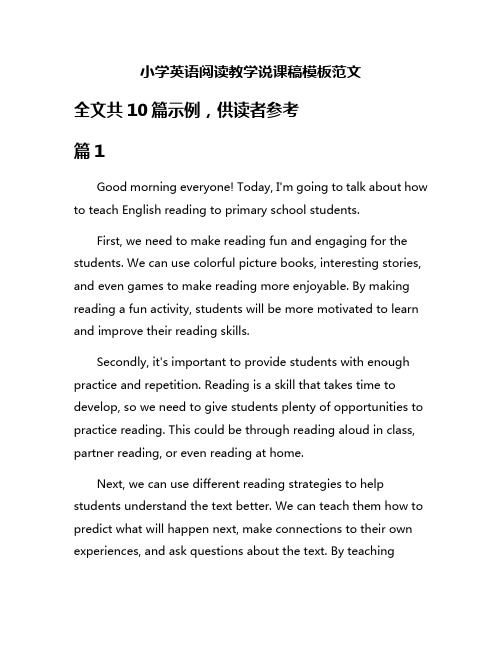
小学英语阅读教学说课稿模板范文全文共10篇示例,供读者参考篇1Good morning everyone! Today, I'm going to talk about how to teach English reading to primary school students.First, we need to make reading fun and engaging for the students. We can use colorful picture books, interesting stories, and even games to make reading more enjoyable. By making reading a fun activity, students will be more motivated to learn and improve their reading skills.Secondly, it's important to provide students with enough practice and repetition. Reading is a skill that takes time to develop, so we need to give students plenty of opportunities to practice reading. This could be through reading aloud in class, partner reading, or even reading at home.Next, we can use different reading strategies to help students understand the text better. We can teach them how to predict what will happen next, make connections to their own experiences, and ask questions about the text. By teachingstudents these strategies, we can help them become more fluent and confident readers.Lastly, we should encourage students to read independently. We can provide them with a variety of books at different levels and genres, so they can choose what interests them. By giving students the freedom to choose what they want to read, we can help them develop a love for reading.In conclusion, teaching English reading to primary school students can be a fun and rewarding experience. By making reading enjoyable, providing practice, using reading strategies, and encouraging independent reading, we can help students become better readers. Thank you for listening!篇2Title: My English Reading LessonHello everyone! Today, I'm going to talk about our English reading lesson. Are you ready? Let's get started!First, we will start by reading a short story together. The story is about a little boy named Tom who goes on an adventure with his dog. As we read the story, I will ask you some questions to check your understanding. Make sure to listen carefully!After reading the story, we will learn some new words. I will write the words on the board and explain their meanings. It's important to learn new words so we can improve our vocabulary.Next, we will practice reading aloud. Each of you will take turns reading a paragraph from the story. Remember to read slowly and clearly, and pay attention to the pronunciation of the words.Then, we will do a fun activity related to the story. We will create our own mini-book using the story we just read. You can draw pictures and write sentences to retell the story. It will be a creative way to practice reading and writing skills.Finally, we will end the lesson by reviewing what we have learned. I will ask you some questions about the story and the new words we learned. You can also ask me any questions you have about the lesson.I hope you enjoy our English reading lesson today. Remember to practice reading every day to become better readers. Thank you for listening! See you next time!篇3Title: My English Reading ClassHi everyone, today I'm going to talk about my English reading class. In our reading class, we learn all about English stories, poems, and even non-fiction texts. We have a lot of fun reading together and discussing the stories with our teacher.First, we start by reading a story together as a class. Our teacher reads out loud, and we follow along in our books. Sometimes we take turns reading paragraphs, and it's really exciting to hear everyone's different voices.Next, our teacher asks us questions about the story. We talk about the characters, the setting, and the main events. It's like we're detectives trying to solve a mystery in the story!After that, we get to do fun activities related to the story. Sometimes we act out scenes from the story, make posters about the characters, or even write our own continuation of the story.At the end of the class, we always have a reading comprehension quiz to see how well we understood the story. It's like a little challenge for us, and we try our best to answer all the questions correctly.I love my English reading class because it's so much fun to read and learn new things. I can't wait for our next story and all the adventures it will bring! Thank you for listening to my say!篇4Today I'm going to talk about how to teach reading to elementary students in English class. Reading is super important because it helps us learn new words, improve our listening skills, and understand different stories.First, we need to make sure the students have a good book to read. We can choose a book that is interesting and appropriate for their level. It's important that the book has pictures to help them understand the story better.Next, we can start by reading the book together as a class. We can ask students to read out loud, and we can also take turns reading different parts of the story. This way, everyone gets a chance to practice their reading skills.After we finish reading the book, we can ask students some questions about the story to see if they understood what they read. We can also do activities like drawing a picture of their favorite part of the story or acting out a scene from the book.Lastly, we can encourage students to read more books on their own. We can recommend other books they might like and create a reading log to track their progress. Reading is a skill thatimproves with practice, so the more they read, the better they will get.In conclusion, teaching reading to elementary students is all about making it fun and engaging. By choosing interesting books, reading together as a class, asking questions, and encouraging independent reading, we can help our students become better readers. Let's keep reading and learning together!篇5Hello everyone, today I'm going to talk about how to teach reading in English to primary school students. Reading is super important because it helps us learn new words, understand different stories, and improve our English skills. So let's get started!When teaching reading to primary school students, it's important to make the lessons fun and engaging. You can start by choosing books that are interesting and age-appropriate for the students. It's also helpful to use pictures and visual aids to help them understand the story better.During the reading lesson, you can use different techniques to help the students understand the text. For example, you canread the story aloud and ask the students to follow along. You can also ask them questions about the story to check their comprehension. It's important to encourage the students to ask questions and make predictions about what will happen next in the story.After reading the story, you can do activities like role-playing, drawing, or writing a summary to help reinforce the students' understanding of the text. You can also encourage them to read the story again at home and discuss it with their families.In conclusion, teaching reading to primary school students is all about making the lessons fun and engaging. By choosing interesting books, using visual aids, and incorporating different activities, you can help the students improve their English skills and develop a love for reading. Thank you for listening, and I hope you found these tips helpful!篇6Title: My English Reading TeachingHello everyone, today I am going to talk about my English reading teaching. In our English class, we have a lot of fun learning new words and stories. Reading is really importantbecause it helps us improve our vocabulary, grammar, and comprehension skills.First, we always start our reading lesson by reviewing the new words we learned in the previous lesson. We go over the pronunciation and meaning of each word, and then we practice using them in sentences. This way, we can remember the words better and use them correctly in our reading.Next, we read a story together as a class. I like to choose stories that are interesting and exciting, so we can all have fun reading them. We take turns reading aloud, and I help the students with any difficult words or phrases. After we finish reading, we discuss the story and answer questions about it. This helps us understand the story better and improve our comprehension skills.Finally, we do some reading exercises to practice what we have learned. We might read a short passage and answer questions about it, or we might do a reading comprehension activity. This helps us reinforce our reading skills and become better readers.In conclusion, reading is a very important part of our English learning. By practicing reading regularly, we can improve our vocabulary, grammar, and comprehension skills. I hope youenjoyed learning about my English reading teaching, and that you will continue to practice reading and improve your English skills. Thank you!篇7Good morning everyone! Today I am going to talk about English reading teaching in elementary school.First, let's talk about why reading is important. Reading can help us learn new words, improve our language skills, and expand our knowledge. It's like going on an adventure in a book!When we are reading, we need to pay attention to the words and the pictures in the book. This can help us understand the story better. We can also ask questions about the story to make sure we understand it.There are many ways to make reading fun. We can read books with our friends, act out the story, or even make our own book to share with others. The most important thing is to have fun while we are reading!As a teacher, I will make sure to choose books that are interesting and at the right level for my students. I will also askquestions and discuss the story with them to help them understand and enjoy reading even more.In conclusion, reading is a wonderful way to learn and have fun at the same time. Let's all remember to read every day and enjoy the magic of books! Thank you for listening.篇8Title: Let's Learn English Reading TogetherHello everyone, today I am going to talk about how to teach English reading to primary school students. Reading is an important skill that helps us learn new things, improve our vocabulary, and have fun! So, let's get started!First, we need to choose a book that is suitable for the students' level. The book should have simple language, interesting stories, and colorful pictures. This will make learning fun and engaging for the students.Next, we should introduce the book to the students and talk about the cover, the title, and the author. We can ask the students to predict what the story might be about based on the cover and title. This will help the students get excited about reading.Then, we can start reading the story together. We should read slowly and clearly, and encourage the students to follow along. We can stop and ask questions to check their understanding, and help them with any new vocabulary.After reading the story, we can have a discussion with the students. We can ask them about their favorite part of the story, what they learned, and how they felt while reading. This will help them think critically about the story and express their opinions.Finally, we can do some fun activities related to the story. We can have the students act out the story, create their own ending, or draw a picture of their favorite scene. This will help reinforce their understanding of the story and make learning enjoyable.In conclusion, teaching English reading to primary school students can be a fun and rewarding experience. By choosing the right book, engaging the students in the story, and doing fun activities, we can help them improve their reading skills and develop a love for reading. Let's continue to learn English reading together! Thank you for listening.篇9Title: My English Reading ClassHi everyone! Today I'm going to talk to you about how I teach English reading in our class. Reading is super important because it helps us learn new words, improve our spelling, and even makes us better at writing.First, I always start by choosing a fun and interesting story to read. It could be about animals, superheroes, or even princesses.I make sure the story is not too easy or too hard, just right for our level.Next, I ask the students to read the story quietly to themselves. This helps them practice their reading skills and understand the story better. After they finish reading, we discuss the main ideas of the story together.Then, I like to do some fun activities to reinforce what we read. We might do a word search, a matching game, or even act out different parts of the story. This way, the students can have fun while learning new words and concepts.Finally, I always encourage my students to keep practicing their reading outside of class. It could be reading books, magazines, or even signs on the street. The more they read, the better they will become at English.In conclusion, reading is a super fun and important part of learning English. I hope you all enjoy reading as much as I do! Thank you for listening and have a great day!篇10Title: My English Reading LessonHello everyone! Today, I'm going to talk about my English reading lesson. We are going to read a story called "The Cat and the Mouse". This story is about a cat who tries to catch a mouse, but he always fails because the mouse is very clever.First, I will show the students the cover of the book and ask them to make predictions about what they think the story is about. Then, we will read the story together as a class. I will ask the students to read out loud and help them with any difficult words.After we finish reading the story, I will ask the students some questions to check their understanding. For example, I will ask them why the cat couldn't catch the mouse and how the mouse outsmarted the cat. I will also ask them to tell me their favorite part of the story and why they liked it.To reinforce their understanding of the story, I will ask the students to draw a picture of their favorite scene from the story and write a sentence describing what is happening in the picture. This will help them remember the story and practice their writing skills.In conclusion, reading is a fun and important part of learning English. By reading stories like "The Cat and the Mouse", students can improve their reading comprehension, vocabulary, and writing skills. I hope my English reading lesson will be enjoyable and educational for my students. Thank you for listening!。
小学英语学科导读教案模板

一、教学目标1. 知识与技能目标:学生能够正确地读、写单词,理解简单的句子,掌握基本的日常用语。
2. 过程与方法目标:通过小组合作、游戏等形式,培养学生的听说读写能力。
3. 情感态度与价值观目标:激发学生学习英语的兴趣,培养学生良好的学习习惯,提高学生的自信心。
二、教学重难点1. 教学重点:单词的读音、拼写,句子的理解和表达。
2. 教学难点:英语语法知识的运用,学生的口语表达能力。
三、教学准备1. 教师准备:PPT课件、单词卡片、图片、录音设备等。
2. 学生准备:预习课本内容,准备相关单词卡片。
四、教学过程1. 导入新课(1)教师用简单的英语问候学生,引入新课。
(2)展示课题,让学生明确本节课的学习目标。
2. 新课呈现(1)教师用PPT展示本节课要学习的单词和句子,让学生跟读。
(2)学生通过小组合作,用卡片展示单词和句子,巩固所学知识。
3. 课堂练习(1)教师设置游戏环节,如“单词接龙”、“句子接龙”等,让学生在游戏中巩固所学知识。
(2)教师提问,检查学生对单词和句子的掌握情况。
4. 语法讲解(1)教师讲解本节课的语法知识,让学生明白语法规则。
(2)学生进行相关练习,巩固语法知识。
5. 口语表达(1)教师创设情境,让学生用所学单词和句子进行口语表达。
(2)学生互相练习,教师给予评价和指导。
6. 总结与作业(1)教师对本节课所学内容进行总结,强调重点和难点。
(2)布置课后作业,如:背诵单词、句子,完成练习册等。
五、教学反思1. 教师应关注学生的个体差异,因材施教,让每个学生都能在课堂上有所收获。
2. 教师应注重激发学生的学习兴趣,采用多种教学方法,提高学生的学习积极性。
3. 教师应关注学生的口语表达能力,鼓励学生在课堂上大胆开口说英语。
4. 教师应加强课后辅导,及时解决学生在学习中遇到的问题。
小学英语教案设计时间模板

一、课时安排1. 教学内容:英语单词、句型、阅读理解等2. 课时:2课时二、教学目标1. 知识目标:(1)学生能够掌握本节课的英语单词、句型。
(2)学生能够阅读并理解英语短文。
2. 能力目标:(1)提高学生的英语听说读写能力。
(2)培养学生的英语思维习惯。
3. 情感目标:(1)激发学生对英语学习的兴趣。
(2)培养学生积极向上的学习态度。
三、教学重难点1. 教学重点:(1)单词、句型的记忆与运用。
(2)阅读理解的技巧与方法。
2. 教学难点:(1)单词、句型的正确发音。
(2)阅读理解中的逻辑推理能力。
四、教学过程第一课时:1. 导入新课(1)复习上节课所学内容。
(2)通过游戏、歌曲等形式,激发学生的学习兴趣。
2. 新课学习(1)教师讲解本节课的单词、句型,并举例说明。
(2)学生跟读、模仿,巩固所学内容。
(3)教师带领学生进行单词、句型的游戏活动,如“单词接龙”、“句子表演”等。
3. 阅读理解(1)教师选取一篇适合学生水平的英语短文,讲解阅读理解的方法。
(2)学生自主阅读短文,完成阅读理解题目。
(3)教师讲解答案,并对学生的阅读理解能力进行评价。
4. 总结与作业(1)教师对本节课所学内容进行总结。
(2)布置课后作业,如背诵单词、句型,完成阅读理解练习等。
第二课时:1. 复习导入(1)复习上节课所学内容。
(2)检查学生的课后作业完成情况。
2. 新课学习(1)教师讲解本节课的单词、句型,并举例说明。
(2)学生跟读、模仿,巩固所学内容。
(3)教师带领学生进行单词、句型的游戏活动,如“单词接龙”、“句子表演”等。
3. 阅读理解(1)教师选取一篇适合学生水平的英语短文,讲解阅读理解的方法。
(2)学生自主阅读短文,完成阅读理解题目。
(3)教师讲解答案,并对学生的阅读理解能力进行评价。
4. 总结与作业(1)教师对本节课所学内容进行总结。
(2)布置课后作业,如背诵单词、句型,完成阅读理解练习等。
五、教学反思1. 教师在课堂教学中,要注意关注学生的个体差异,因材施教。
